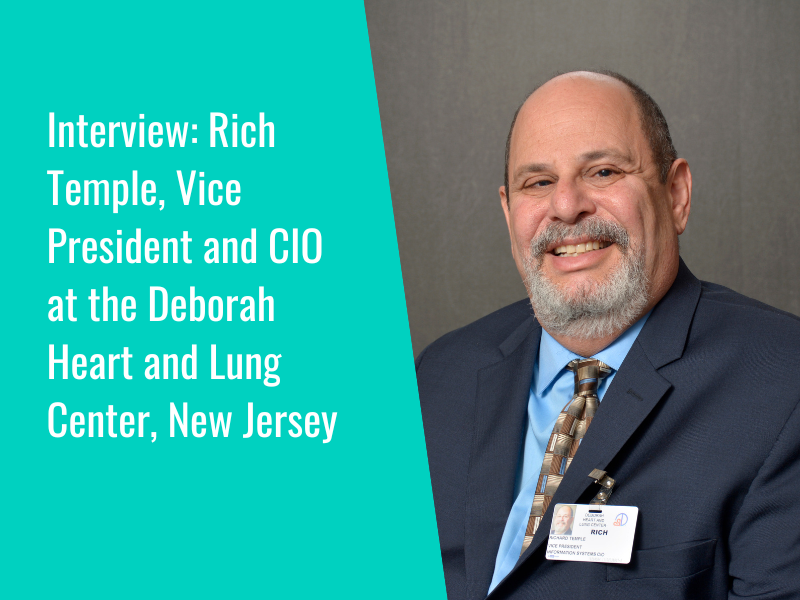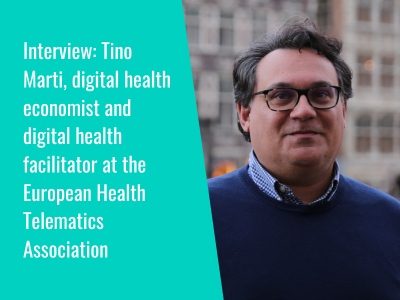Yesterday we held our first international webinar, where we were joined by a panel of health tech experts to discuss current digital capabilities, projects, and priorities from country contexts including Spain, Bermuda, and the UK.
We welcomed Keltie Jamieson, chief health information officer with the Bermuda Hospitals Board; Tino Marti, digital health facilitator at the European Health Telematics Association (EHTEL) in Spain; and Penny Kechagioglou, chief clinical information officer and deputy chief medical officer at University Hospitals Coventry and Warwickshire.
Introductions
To begin, each of our panellists offered a brief introduction to themselves and their role.
Keltie talked about her last year-and-a-half within the health system in Bermuda, as well as her background as a CIO in Nova Scotia and Alberta, Canada, working on implementations including an EPIC implementation that she called “the largest in the world”.
Penny shared some of her work as a CCIO in the UK, sharing that her team is currently “about seven weeks away from implementing an EPR system”, and that her responsibilities on a day-to-day basis include overseeing the organisation’s digital strategy and transformation, quality improvement, and innovations such as using AI to improve outcomes, patient flow and productivity.
Tino took us through his current role collaborating with EHTEL, as well as his background working for the Department of Health in Catalonia, and as a technical officer in primary care for the World Health Organization’s European region, based in Kazakhstan.
Current levels of digital maturity
To kick off discussion, we asked our panellists to share a little about their region’s digital maturity and any progress being made on digital transformation.
Tino talked about his experience of deploying digital health initiatives in Catalonia, a process he pinpoints as “starting back in 1998 with the first primary healthcare record”, and advancements made around interoperability to help improve data flow between healthcare professionals and patients.
On the current situation in Bermuda, Keltie told us that when she arrived 18 months ago, “we were two months away from launching our electronic patient record, so it was a bit of a trial by fire”. As such she has led an implementation that is now largely complete alongside a “great team”, covering a population of around 65,000, and in the face of challenges around getting resources as an island.
From the UK perspective, Penny highlighted that the priority is for every trust to have an electronic patient record by December 2026, and that at the moment, the focus is on how data can be linked together, as well as “where we can use anonymised data for research and for clinical decision support”. She also highlighted work on the NHS’s Federated Data Platform, on citizen engagement, patient portals, and population health management challenges around inequalities.
Challenges in the digital health space
Moving on to discuss challenges, each of our panellists shared details on some of the current challenges within their role or organisation.
Referring to the Catalan health system, Tino highlighted difficulties due to the “completely fragmented landscape of health information systems”.
He said: “We’re covering 7.8 million people with universal health coverage, and we have 65 acute hospitals serving this population, with 22 different hospital information systems. So now we have this fragmentation that is hampering how innovation can be scaled-up. If you have a good implementation in one hospital that integrates information with primary healthcare in this new solution, when you want to scale-up, you will have to make 22 different adaptations.”
Tino said that in tackling this challenge, the shared electronic health record approach, or having all hospitals and healthcare providers publishing information in a common layer, “is very good for exchanging data between healthcare providers – but it doesn’t look at the level of processes, so there is a need to do something else.”
A strategy formulated in 2018, he continued, was based around the idea of decoupling applications from data, so that “no matter who’s providing the service, they have to adapt to this common structure of data”.
From the European perspective, Tino told us that whilst “there is a lot of innovation and product innovation funded by the European Commission”, he views a lot of the projects as “not sustainable”.
Noting that there is currently discussion about how we can make innovation sustainable, and discussion about the methods to scale up that innovation, Tino shared: “We’re working on a project called Digital Health Uptake, where we’re identifying methodologies and tools that help implementers both from the supply side and the demand side, to implement and scale-up their solutions based on on good practice. There is a need to foster this innovation moving forward.”
Keltie raised the need to embrace failures, saying “innovation typically fails 50 percent of the time, and that’s OK, because when you fail, you learn and improve.”
She continued: “It’s about the lessons we learn and the research papers we write and taking things to the next level, because if we are always successful then I’d argue we’re not being innovative at all. There is a publication bias in that we only publish when it’s successful; and then we don’t have that possibility of learning. That’s disappointing, I think.”
Penny agreed with this point around the importance of failure, adding: “That goes hand-in-hand with the culture of organisations, allowing our people to innovate, and to try and fail. As innovators within the organisation, we have to give people that permission to fail. We have to say: that’s OK, how can we learn, how can we move forward? I agree fully with the point around publishing on that, too.”
Another challenge Keltie noted was around recruitment and retaining staff on the island, sharing that there is currently a lack of nursing and home care services. At present, she is working on “trying to use the data we have to determine where those tension points are around patient flow, and starting to give people a better snapshot of what’s going on in the hospital”.
From the NHS perspective there is also a challenge around very high demand for emergency services, Penny noted, with primary and secondary care also being “quite overloaded”. She expanded on this point, saying: “We’re trying to manage demand, and our healthcare records don’t cater for community and social care; so how do we ensure that what’s happening in the community is fed back into the electronic patient records?
“Interoperability is something else we’re trying to address with the Shared Care Record and the Federated Data Platform, and we’re also looking at upskilling the workforce around digital and instilling a digital-first attitude and approach.”
Improving interoperability
Focusing in on the challenge of interoperability, Keltie told us how in Bermuda, there is “very little in interoperability”. She also shared some of her insights from her work in Canada.
“One of the projects we’re just about to kick off is a new integration engine. Our current integration engine is antiquated, and is going to limit our ability to connect the way we want to with the community. So it’s mostly inter-hospital things and basic stuff,” she said.
“Canada also continues to prioritise interoperability, but if we don’t talk about how we’re going to standardise data and share data in a semantic way, we’re never going to be able to really share outside of the provinces easily.”
Due to Canada being “provincially controlled”, Keltie continued, “even if we get federal money to help us, the provinces don’t do things the same way; so we have a national drug information specification that’s implemented 12 different ways.”
“I think that’s the downside of having a provincial body and not a national body that has that governance. There’s a lot of clean-up to do before we’re going to be having any amount of interoperability between provinces. Within provinces, most of them have a drug information system and electronic master patient index and are exchanging data that way, and some have started to get more into the e-referral-type space. But I don’t think we’ve cracked the nut on real interoperability by any stretch.”
Tino talked about the current situation in Catalonia, noting that “it’s a challenge that has already been addressed, and the solution is pretty good in terms of collaboration between levels of primary and secondary care”, but that this is “only at regional level”.
“If you move from region to region, then you are facing interoperability issues, and if you cross the border from Spain to France, for instance, then it’s another completely different picture, so I think it will be never-ending unless there are new approaches and a common data model.”
In terms of news on this topic, Tino noted that European health data regulation is “now in progress” when it comes to providing common standards for EHR data across Europe, in the hopes that this might help with exchanging basic information for Europeans travelling across Europe.
“In Catalonia, we have implemented something where, through your personal health record, you can download your data from your mobile or computer, and this data can be exchanged with other healthcare providers as a way of getting around challenges with interoperability,” he shared. “I think this is a good opportunity to make systems more permeable to innovation.”
Patient involvement
On the topic of getting patients involved in the process, Keltie talked about her experience from Bermuda, where a national patient portal was actually purchased by the hospital within their EPR. However, she said, “We’ve been waiting to see what’s going to happen at the national level, so that we don’t end up with two patient portals on a small island. I’m hoping that we hear more soon so that we can move forward.”
Canada, she reflected, has had an “interesting path with patient portals. They seem to have figured it out a little bit better under the pressures of COVID; but actually some of the first patient portal projects that came into Canada were unsuccessful, because clinicians weren’t comfortable just blanket-sharing information with patients, they wanted to have a level of control over what was released. Now, however, i think most provinces now have some level of portal access.”
From the UK context, Penny shared that whilst having the information in the same place for clinicians to make decision about care “is vital – but also equally for managers, it’s important that they can understand what is happening within a system.”
Her trust is implementing its EPR in the same instance as its system partners, Penny continued, which is “very important because that goes back to interoperability. Regionally, we are very good at interoperability; but moving from one region to another, that is where it becomes difficult.”
Penny added that a lot of work has been done recently around process mining and AI “to try different things and understand what the impact is on patient flow and on DNA rates, and we have made some really good improvements by just using our data well, having clinicians working with data analytics, people working with user design.”
Making use of data for research and innovation
We took the opportunity to ask our panellists about any research projects they are currently working on in this area, and their findings so far.
On informatics, Keltie said that her team’s focus is first on the problem to be solved, adding that “too often, people come to us with solutions and that might not be the best solution; if we drill into the problem they’re actually trying to solve, we may be able to do it in a much more eloquent way.”
She said: “I think the research methodology around asking questions, co-designing, and documenting your findings not only gives you a framework for thinking about problem solving and design; but it gives you credibility as we start to publish, that we are a group that is doing that level of thinking. With the national digital health strategy, if we can be seen as a place you can do research with – we’ve a very interesting, contained dataset of 65,000 people – are we able to partially fund our national strategy work out of research investment and economic development startups.”
The issue with this small of a dataset, Keltie continued, is that “most people know each other”, which makes the concept of someone doing research with their data “a little bit tense”. In response to this, Keltie’s team have been looking at de-identification and using synthetic data.
Tino echoed the challenges Keltie voiced around secondary use of data, stating that this was an issue faced in Catalonia some years ago, which led health authorities to “develop a sort of data space where only public health care providers and public research institutions have access to this data”.
He continued: “I think there is a moral obligation of getting value out of this, so facilitating access to this growth of data is something that is necessary. What is happening, in reality, is that because we have this fragmented system, we also see fragmentation in the use of data, with each healthcare provider having a unit of research, collecting data, and also using this common space facilitated by the government.”
Since the turn of the century, Tino noted that “the system has been thinking first in covering the need; but we’re leaving this footprint of data that now has real potential, as we’re discovering the possibilities with more data and more detailed data, of tailoring new services, implementing algorithms, developing clinical decision support systems, and so on.”
He commented that the current system was “inspired by the quality and outcomes framework from NHS England”, with a list of indicators developed that are automatically calculated based on the data you’re recording in your electronic health record. “You have access to this information at GP level, at primary care team level, and between primary care teams across Catalonia. But we have a huge opportunity to explore this data to improve the quality of services in many different ways now, so I’m very optimistic, and I think we’re just entering into this stage.”
Measuring success
Moved on to discuss how success can be measured in digital programmes, Penny considered: “It starts with a good vision and what outcomes you want to achieve; that’s a really important aspect for our teams, organisations and systems to set up from the beginning.”
For the UK, she drew attention to the What Good Looks Like framework, explaining that it is followed in terms of specific success metrics from an organisation perspective. “Success for me, though, is also the degree of engagement, ownership of change, innovation, and the outcomes we measure in evaluation, the benefits to patients and their experience,” she pointed out. “Having happy customers, patients and users, and achieving the benefits that were set out in the vision – that is a good measure of success.”
Keltie agreed with Penny on the importance of having a strong vision in place from the beginning, saying that one of the things she tells her team is that “we want our customers to feel supported, to know and trust that we are there; and that is the key tenet for me of digital transformation, around the connection, meeting people where they are, engaging in co-design”.
When IT and technology was new, she said, “it was very much that people were just lucky when we answered their call; whereas now it really is around making a stronger workforce, promoting better outcomes, and so on. It’s a real culture shift in teams that have grown up in the traditional model, to try to be pushed into this more engaged model. I like to say that my team is part of the clinical care team; we don’t touch the patients, but all of our tools do, and so we have to respect that important role that we have.”
Tino talked about the different measures of success around value, clinical value, social value, and economic value, highlighting the importance of being able to utilise these in demonstrating that “investment in digital health has paid off”. If we can evaluate long-term trends and see how care has changed during different implementations, he said, we can measure improvements.
The future of global digital health
To close the panel, our discussion moved on to consider the future of digital health globally, and what it might look like in ten years’ time.
Keltie’s view of future digital health in Bermuda centred around creating “a cohesive record across the country”, which she highlighted as a “game changer”.
She said: “We have some of the highest rates of diabetes and kidney failure in the OECD countries, so there’s a significant value proposition for us to be able to share data in a much more cohesive way, and I think that’s really going to drive it home.”
Something that Keltie noted needs continuing focus is cyber security. “We can put in all the digital tools we want, but I think we are still going to be struggling with maintaining the security of the systems,” she acknowledged.
Tino talked about the potential for a “widening gap” in adoption, “because digital health is accelerating in terms of possibilities, but the adoption capacity of our institutions is very low.” He also considered that “we will probably see completely different speeds of uptake, depending on the flexibility of the organisation and how it can adapt to emerging technologies. But at the same time, since the introduction of digital health, I would say that the way we work is pretty much the same. We have new tools that improve our way of working, but culturally I think it’s quite difficult to change within ten years.”
For the UK, Penny said, the digital future involves the better linking of data, and the use of data in predicting illness, treating people, addressing risk factors before illness happens; and understanding these risk factors at population level.
We’d like to thank Penny, Keltie and Tino for taking the time to share their insights and experiences with us for this webinar.
- 1
- 2














